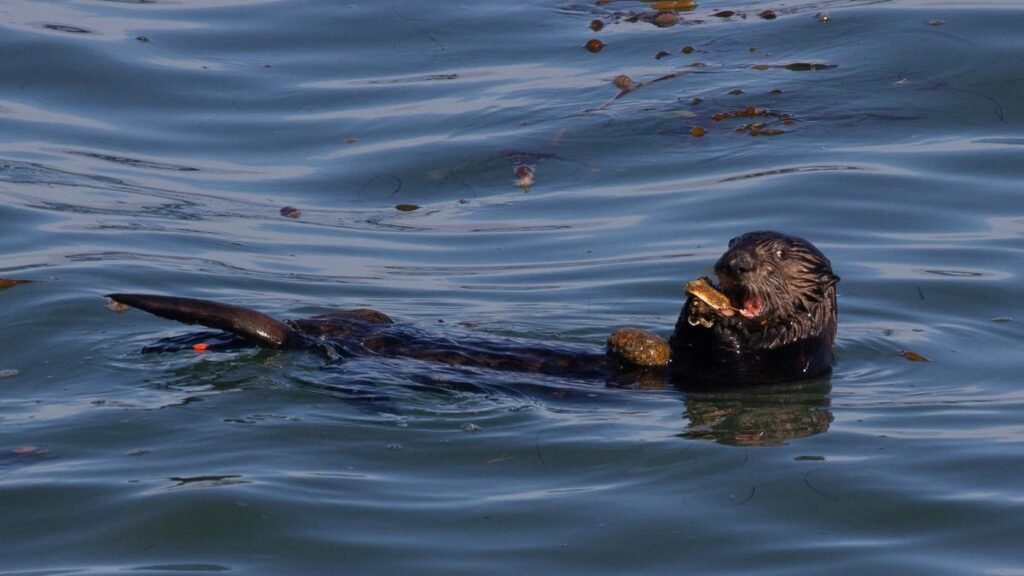An undated handout image shows a southern sea otter using a rock anvil to break open shells of prey, in the Pacific Ocean off the coast of California, U.S.
| Photo Credit: Reuters
Humans are not alone in the use of tools. Chimpanzees, for instance, crack nuts with stones and use sticks to get at tasty termites. Dolphins are known to employ sponges to protect their beaks while foraging. And a Galapagos Islands finch uses cactus spines to dig grubs out of holes.
Sea otters also are members of the animal kingdom’s tool-wielding club. And a new study offers a fuller understanding of the tool use – utilizing rocks and other objects to break open hard prey – by these marine mammals. It lets the otters eat certain larger prey and reduces their tooth damage by cutting down on their chomping down on hard shells, with females using tools more than males, perhaps to compensate for their smaller body size and weaker bite force, researchers found.
The researchers observed 196 southern sea otters along the central California coastline – Big Sur, Monterey, San Luis Obispo, Piedras Blancas and Elkhorn Slough.
When not crushing prey with their teeth, the otters float on their backs when feeding and use rocks, shells and discarded bottles as hammers or anvils to smash open hard-shelled prey, also sometimes bashing prey onto the surfaces of docks and boats.
An undated handout image shows a southern sea otter preying on a marine animal, in the Pacific Ocean off the coast of California, U.S.
| Photo Credit:
Reuters
Among the prey were sea urchins, abalone, crabs, mussels, clams, snails and fat innkeeper worms. The shells of certain larger prey would be too tough, without tools, to break to gain access to the edible soft parts inside. For instance, mussels, clams and snails would otherwise be unavailable.
“Tool use allows individuals to maintain energetic requirements through the processing of alternative hard prey that are typically inaccessible with biting alone, suggesting that this behavior is a necessity for the survival of some otters in environments with limited resources,” said evolutionary biologist Chris Law of the University of Texas and University of Washington, lead author of the study published on Thursday in the journal Science.
The frequency of tool-use behavior varies, with some otters doing it more than 90% of the time when feeding and others rarely or never, according to study co-author Rita Mehta, a University of California, Santa Cruz functional and comparative biologist.
Tool use was particularly important for the female otters.
“Females need the calories. They are smaller than males, and pregnant or nursing females have elevated caloric demands. Tool-using females were shown to consume a greater proportion of very large prey to help them meet their caloric needs,” Mehta said.
An adult sea otter pushes a sea otter pup on the surface of the Elkhorn Slough in Moss Landing, California, U.S. May 14, 2021. Picture taken May 14, 2021.
| Photo Credit:
Reuters
The southern sea otters, a subspecies also called the California sea otter, can reach up to four feet (1.2 meters) long. Males weigh up to about 70 pounds (32 kg) and females up to about 50 pounds (23 kg).
Eating hard-shelled prey, as the otters do, can lead to broken teeth.
“Without their teeth, otters can’t eat and will die. Females show slightly less damage to their teeth overall, probably because of their increased tool use,” Law said.
Sea otters, the largest member of the weasel family, generally eat food equal to about a quarter of their body weight daily as they prowl kelp forests and seagrass beds. The population of southern sea otters along California’s coastline numbers only about 3,000.
The otters were opportunistic in terms of their tools.
“Otters are intelligent mammals, and they are very strong. People who live along the bay commonly observe otters using a variety of human-discarded material as tools, from glass bottles to pieces of plastic, so otters seem flexible in what they may try to use to break open prey,” Mehta said.
